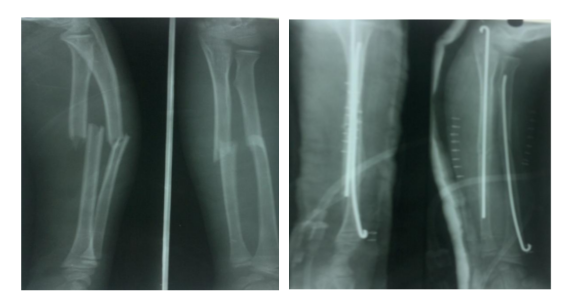Pediatric forearm fractures, particularly diaphyseal fractures involving both the radius and ulna, are among the most common orthopedic injuries in children, accounting for 13% to 40% of all pediatric fractures. While the majority of these fractures can be managed conservatively with closed reduction and casting, certain cases—such as unstable, open, or irreducible fractures—necessitate surgical intervention. In such scenarios, intramedullary fixation using stainless steel Rush pins offers a minimally invasive, effective, and economical alternative, especially in resource-limited settings.

Origins and Indications of Rush Pins
The Rush pin was developed in the 1930s by Dr. Leslie Rush, an American surgeon who pioneered the technique of internal bone fixation. His innovation led to the creation of the Rush pin, a flexible intramedullary nail designed to stabilize long bone fractures.
Rush pins are particularly indicated for pediatric diaphyseal forearm fractures that are unstable, open, or irreducible. They are also suitable for cases where conservative management has failed or is likely to fail. The pins are inserted intramedullary, providing internal support while preserving the periosteal blood supply and minimizing soft tissue disruption.
Advantages of Using Stainless Steel Rush Pins
Minimally Invasive Technique: The insertion of Rush pins requires small incisions, leading to reduced surgical trauma and better cosmetic outcomes.
Cost-Effectiveness: Compared to titanium elastic nails, stainless steel Rush pins are more affordable and widely available, making them an ideal choice in developing countries.
Effective Stabilization: Rush pins provide adequate stabilization for diaphyseal fractures, promoting proper alignment and facilitating early mobilization.
Ease of Removal: The design of Rush pins allows for straightforward removal once the fracture has healed, typically without the need for extensive surgical intervention.
Low Complication Rates: Studies have shown that the use of Rush pins in pediatric forearm fractures results in high rates of fracture union and low incidence of complications.
Clinical Outcomes
Clinical studies have demonstrated the efficacy of Rush pins in managing pediatric diaphyseal forearm fractures. In a study conducted in Nepal, 30 children treated with intramedullary Rush pins achieved fracture union in an average of 6.5 weeks, with 83.3% attaining excellent results and 16.6% good results. Another study involving 50 pediatric patients reported that 94% achieved excellent outcomes, with all fractures maintaining good alignment post-operatively and radiological union observed within three months.
Conclusion
Stainless steel Rush pins offer a reliable, cost-effective, and minimally invasive option for the surgical management of pediatric diaphyseal forearm fractures. Their ease of use, affordability, and favorable clinical outcomes make them particularly valuable in settings where resources are limited. As such, Rush pins remain a pertinent choice in the orthopedic treatment arsenal for pediatric forearm fractures.